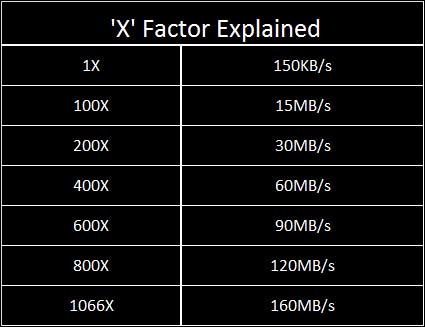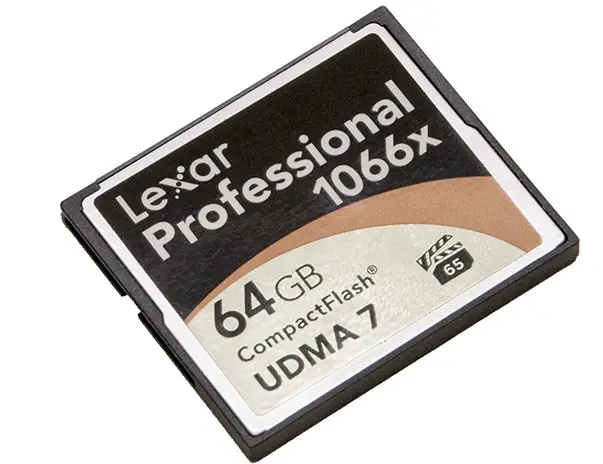
Even experienced camera enthusiasts probably have not spent much time thinking about the CF cards they use. Instead they simply plop them in, fill them up, and rinse & repeat until the photoshoot is complete. However, if you take the time to think about it CompactFlash has a staying power that borders on the insane for computing industry. In fact when it was first released CF was only one of many standards, and many did not give it great odds of beating Sony’s then latest MediaStick standard.
To understand CF and its strengths and weaknesses we have to travel back in time to the early ’90s when things like Chip & Pepper shirts, floppy disks, and CD-ROMs were popular. Back then a consortium of manufactures realized that the state of the portable storage industry was a mess and that ‘one standard to rule them all’ storage medium was needed. A new standard that would be highly adaptable, extremely robust, and above all else be quickly and easily adopted by even the most conservative of companies. If all that was not enough, it also had to be fairly cheap to implement.
In order to do all this in as short a period of time (and as cheaply as possible) the Compact Flash Association (the governing body of the CF standard) took the then cutting edge PCMICA interface standard, cut it down from 68 pins to 50 pins and added in a version of the Parallel ATA communications standard. This may sound like a very inelegant solution, but at the time this allowed CF cards the ability to not only be readily adapted to a wide variety of tasks (as they are seen by computing devices as nothing more than a IDE ATA hard drive); but also allowed camera manufactures the luxury of using a very stable, very inexpensive, and very well understood technology inside their cameras. Put another way CompactFlash Association was not trying to reinvent the wheel like other solutions were, instead they wanted to get the job done ASAP and revisit and refine as needed later.
The downside to this design standard is that CompactFlash relies on 50 very delicate pins, and bending any one of them results not in a dead – but easily replaceable- card but a dead-lined camera…which is not as easily replaced or repaired. Also as history has there is a limit to how far you can ramp up the signaling speed on parallel interfaces before error levels outstrip the performance increases. This last issue was not known back in the 90’s, but is the main reason parallel interfaces have been replaced by serial wherever possible.

From a consumers perspective CF also suffers from a now antiquated speed rating system that few novices will intuitively understand. As we said the CFA were not interested in reinventing the wheel, so along with co-opting the physical and signaling standards they also ‘borrowed’ another standards performance rating scale. Much like CD-Roms, CompactFlash cards are rated in ‘X’ speeds, with 1X being equivalent to 150KB/second of read performance – or what audio CD’s needed to provide for lag free music playback. This means a 30MB/s card has a rating of 200X, a 120MB/s card is 800X, and a 1066X card is 160MB/s. However this rating is not all that helpful as unlike Compact Discs, CompactFlash drives write speed is arguably more important than read. This is why not all cards rated for a given ‘X’ are actually capable of the same performance levels and why a no-name 800X card may only have the same write performance of a Lexar 600X card….or even less.
Needless to say this does lead to consumer confusion and why experienced users rarely go beyond NAND manufactures own cards when looking for a CF card to buy. This ultra-conservativism is also why ‘Lexar’ does not have the same market penetration as SanDisk…as SanDisk is a known NAND manufacturer, and were one of the main backers of the CF standards; whereas not everyone knows that Lexar is owned by Micron and uses Micron NAND – who also played a large role in the CF standards, as is one of the largest NAND manufactures in the world! The upside to this is that ‘Lexar’ CompactFlash drives can be found for significantly less than their SanDisk counterparts, and why Lexar has a peerless price to performance ratio.
So why did CF quickly gain traction and keep its market dominance in DSLR cameras while the rest of the world moved on to SD/SDHC/SDXC/XQD/partridge in a pear tree? Size and price. As previously stated PATA controllers were a dime a dozen by the late 90s, and low power controllers were even easier to source at rock bottom prices. This allowed the main controller to be moved off the camera and on to the actual card. Compare and contrast that to SD/MMC/xD/Memory Stick/etc which only had a few more expensive controller options (at best) available, requires the camera manufacturer to include them inside the camera body, and you can quickly understand why camera manufactures were keen on opting for the CF interface.

The reason CF has had the staying power that few expected is not as simple to answer. On the surface a 43x36x3.3mm form-factor is not a positive attribute to have in a portable storage medium – as that is a lot of prime real-estate. However all this room allows for four NAND ICs that use the typical form-factor IC size. More NAND ICs in a standard NAND package means that manufactures can not only use lower NAND than SDXC & XQD cards, but they are also less costly to source, and having (up to) four NAND ICs greatly improves overall performance during heavy I/O loads – say when you are burst shooting and need the RAW images dumped to the card as fast as possible.

As an added bonus, this increased size allows the internal NAND the luxury of a larger surface area to dump excess heat. In fact, if you pay careful attention to the typical CF card you will notice both the top and bottom surfaces are metal and not plastic – like they are in SD cards. During high intensity photoshoots we have literally fried SD cards, because they just don’t have built in heatsinks, but in over a decade & half of use we have never had a Lexar or SanDisk CF die from overheating. The worst we had was rather warm CF cards by the end of the day. This level of trustworthiness, and sterling reputation amongst professionals, is why CF cards remain the de-facto standard on all cameras above entry level.
Those are the benefits CF offer over the competition, sadly after nearly twenty years we have finally reached a point where CF will shortly no longer be able to be fast enough to keep up with demands. Not only do we have cameras that are now capable of 14 frames per second, but we also have 50Megapixel cameras that create files that are mindbogglingly massive. Worse still these increasing demands on the storage device are only going to accelerate as time goes by. Unfortunately by co-opting the PCMCIA and PATA standards, SanDisk created a ‘new’ standard that maxes out at just north of 166MB/s. While yes it is possible to see the CFA create a ‘UDMA 8’ standard, like they did with UDMA 7, we are reaching the point where the physical Parallel interface may be the major limiting factor.
Put another way Lexar’s Professional 1066X series is about as fast as CF allows for and there is probably very little room left for future growth. On the upside, this mature technology is relative inexpensive now and a 64GB CF card that are capable of 150MB/s write speed costs only about $85. This is why we don’t see CF going away anytime soon, but we do see its days of being the first pick for professionals as being numbered….assuming CFast 2.0 starts gaining some much needed traction with either Canon, Nikon, Sony. The next generation Nikon (‘D5’), and Canon (‘D 1x II’) landing late this year early next (in time for the bugs to be worked out before the Olympics) will be a hint at which way the industry goes.











